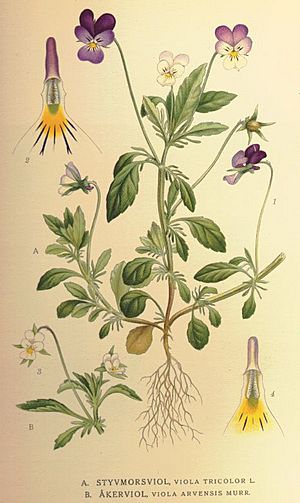Viola tricolor facts for kids
Quick facts for kids Heartsease |
|
|---|---|
 |
|
| Scientific classification | |
| Genus: |
Viola (plant)
|
| Species: |
tricolor
|
The Wild pansy' (Viola tricolor) is a common wild flower found in Europe. It's also known by many fun names like Johnny Jump up, heartsease, tickle-my-fancy, and Jack-jump-up-and-kiss-me! This plant can grow for just one year (an annual) or for a few years (a short-lived perennial).
It has also been brought to North America, where it has spread widely. The wild pansy is the original plant that all the beautiful garden pansies we see today came from. This is why it's sometimes called the "wild pansy." Before garden pansies existed, "pansy" was just another name for this wild flower. Its flowers can be purple, blue, yellow, or white, and it can produce up to 50 seeds at one time!
Contents
What Does the Wild Pansy Look Like?
The Viola tricolor is a small plant. It usually grows low to the ground and spreads out, reaching about 15 cm (6 inches) tall. Its flowers are about 1.5 cm across. You can find it growing in short grassy areas on farms and in empty lots, especially where the soil is a bit acidic or neutral. It likes places with some shade.
The plant has roots that spread underground, called a rhizome, with many small rootlets. Its stem is usually smooth, sometimes a little fuzzy, and has branches. Unlike some other violets, this plant doesn't have a bunch of leaves at its base. Instead, its leaves grow one after another along the stem. These leaves are oval or long and narrow, with slightly jagged edges. It also has special leaf-like parts called stipules, which are often quite big, especially on the upper leaves.
The flowers grow alone on long stalks called peduncles. They appear on the parts of the stem that grow above ground. The green parts under the flower (sepals) are never bigger than the colorful petals (corolla). The flower itself can be 10 to 25 mm long. Its petals can be purple, blue, yellow, or white. Often, they are two colors, like yellow and purple. The most popular kind has three colors: yellow, white, and purple.
Wild pansies bloom from April to September in the Northern Hemisphere. These plants have both male and female parts (they are hermaphrodites), meaning they can produce seeds on their own (they are self-fertile). Bees help them spread their pollen.
Where Does the Wild Pansy Grow?
This flower is very common almost everywhere in Europe and Asia. You can find it near the sea or far inland, from sea level up to 2,700 meters high in mountains. It likes to grow in open grasslands and empty areas, especially in soil that is acidic or neutral. You can also spot it along riverbanks and in areas where rivers have left behind soil (called alluviums).
Traditional Uses and Benefits
The wild pansy has been used for a very long time in herbalism (using plants for health) and folk medicine. Some of its old names, like "heartsease," hint at its traditional uses. People used it for skin problems like eczema, and for breathing issues such as bronchitis, asthma, and cold symptoms.
It was also used as a diuretic, which means it helps the body get rid of extra water. Because of this, it was traditionally used for conditions like rheumatism (joint pain) and cystitis (bladder problems).
Beyond medicine, the flowers have been used to make yellow, green, and blue-green dyes. The leaves can even be used to test how acidic something is, like a simple pH indicator.
Mythology and Legends
The wild pansy has some interesting stories connected to it!
According to Roman mythology, the god of love, Cupid, once shot an arrow at a queen, but he missed! Instead, the arrow hit a wild pansy. Because Cupid is the god of desire, the flower's juice gained a magical power to act like a love potion. Its name "Love-in-idleness" might come from this story, as it was sometimes used in playful or mischievous acts.
In Greek mythology, the powerful god Zeus fell in love with a young woman named Io. To hide her from his jealous wife, Hera, Zeus turned Io into a heifer (a young cow). He kept her grazing at his feet. Feeling sorry for Io, who only had grass to eat, Zeus made beautiful flowers grow from the earth just for her. He called these flowers "Io." Another Greek legend says that the delicate white flowers were once loved by Eros (the Greek god of love). To stop this worship, Aphrodite (the goddess of beauty) colored them, which is how they got their three colors!
Both the ancient Greeks and Chinese used these flowers as medicine. The Celts and Romans even made perfumes from them.
See also
 In Spanish: Viola tricolor para niños
In Spanish: Viola tricolor para niños


